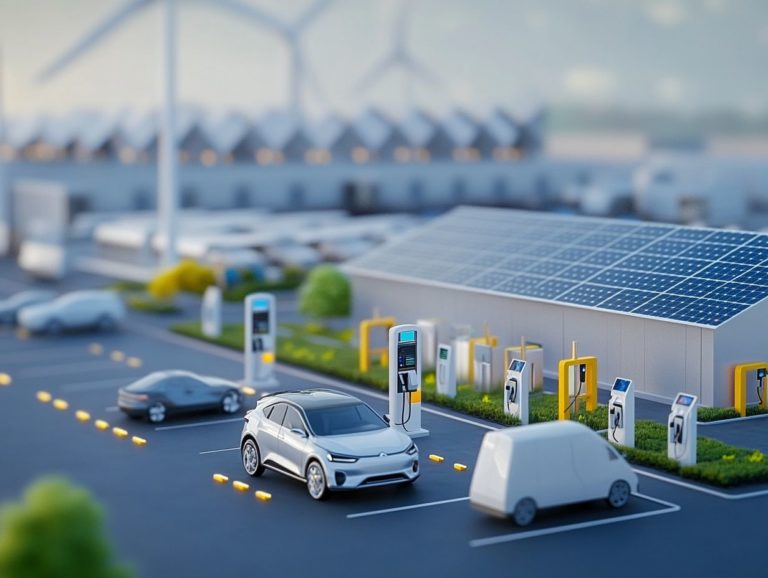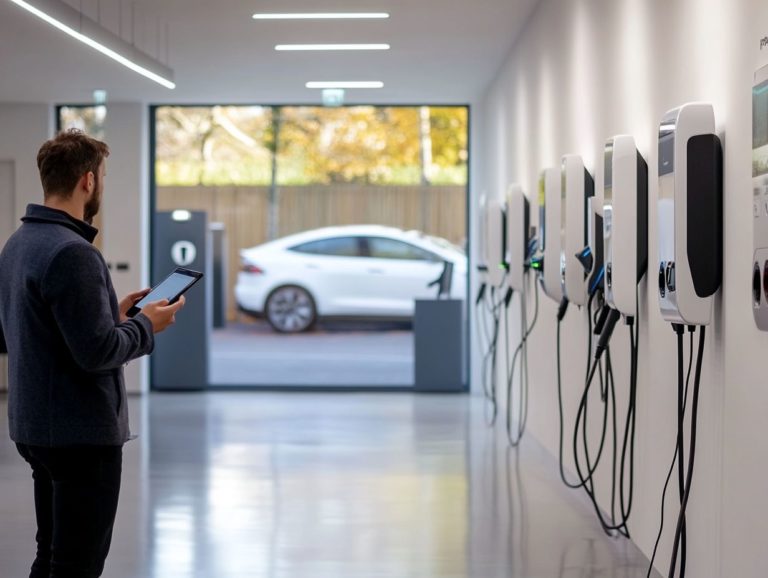5 Charging Solutions for Rural Communities
In an increasingly connected world, having access to reliable charging solutions is essential, especially in rural communities where electricity can be limited.
This article explores five innovative and sustainable charging options that utilize renewable energy sources, such as solar-powered stations, wind, and biogas systems. It addresses the challenges faced by these communities and highlights the benefits of implementing such solutions, demonstrating how local involvement can enhance their effectiveness.
By exploring these aspects, you will uncover the transformative potential of charging solutions to improve education and information access in rural areas. Join us as we unveil how these initiatives can drive lasting positive change.
Contents
- Key Takeaways:
- 1. Solar-Powered Charging Stations
- 2. Hand-Cranked Charging Devices
- 3. Biogas-Powered Charging Stations
- 4. Wind-Powered Charging Stations
- 5. Micro-Hydro Charging Systems
- Challenges of Providing Charging Solutions in Rural Areas
- Benefits of Using Renewable Energy for Charging Solutions
- Involving Local Communities in Implementing Charging Solutions
- Choosing the Right Charging Solution for a Rural Community
- Improving Access to Education and Information in Rural Areas
- Long-Term Effects of Implementing Charging Solutions in Rural Communities
- Your Questions About Charging Solutions Answered!
- What are the top 5 charging solutions for rural communities?
- How do solar-powered charging stations benefit rural communities?
- Can portable chargers be used in rural areas without electricity?
- What are microgrids and how do they work as a charging solution?
- How does a biogas-powered generator work as a charging solution?
- What are the benefits of using hand-cranked chargers in rural communities?
- Summary
Key Takeaways:
- Renewable energy charging solutions are sustainable and cost-effective.
- Local community involvement enhances ownership and sustainability.
- These solutions improve access to education and information, leading to long-term development.
1. Solar-Powered Charging Stations
Solar-powered charging stations provide a sustainable solution for rural areas, especially as electric vehicle (EV) demand rises. These stations serve as essential infrastructure, reducing transportation costs and minimizing environmental impact.
They utilize technology that converts sunlight into electricity, ensuring a reliable power source for EVs. Beyond facilitating local commuting, these installations encourage community engagement and partnerships between government entities and local businesses.
As the world shifts toward renewable energy, rural communities can actively participate in this growing industry while advancing toward energy independence.
2. Hand-Cranked Charging Devices
Hand-cranked charging devices offer an accessible solution for rural communities, allowing residents to charge EVs without relying on conventional power sources. They are practical and user-friendly, empowering individuals to control their energy needs.
Especially during natural disasters, when traditional power supplies may fail, these devices keep communities connected and mobile.
3. Biogas-Powered Charging Stations
Biogas-powered charging stations convert organic waste into usable energy for EVs, significantly reducing environmental impact in areas lacking traditional energy sources. They leverage a process involving bacteria that breaks down waste without oxygen, producing biogas as a byproduct.
Successful projects in regions like India and Africa demonstrate how these systems can electrify schools and power local transport, promoting self-sufficiency and environmental stewardship.
4. Wind-Powered Charging Stations
Wind-powered charging stations harness natural energy for EVs, particularly in rural areas with strong wind potential. They play a crucial role in reducing harmful emissions while providing an affordable power source for electric transportation.
This approach encourages community involvement, allowing residents to participate in planning and installation, fostering a shared sense of ownership in the shift toward renewable energy.
5. Micro-Hydro Charging Systems
Micro-hydro charging systems transform flowing water into electricity for charging stations, enhancing energy access while reducing reliance on traditional sources. These systems use turbines to sustainably generate electricity, requiring minimal infrastructure.
By utilizing local water resources, micro-hydro systems strengthen transportation infrastructure and contribute to a decrease in harmful emissions, stimulating economic development and opening doors to sustainable practices.
Challenges of Providing Charging Solutions in Rural Areas
Providing effective charging solutions presents unique challenges, including limited funding sources and inadequate infrastructure planning. It’s essential to ensure that EV charging stations meet local needs while addressing environmental impacts.
Geographical barriers may complicate charger installation, particularly in remote locations where grid connectivity is lacking. Local stakeholders, like electric cooperatives and municipal governments, play a critical role in finding funding options and engaging residents in the planning process.
Benefits of Using Renewable Energy for Charging Solutions
Using renewable energy for chargers significantly benefits the environment by supporting sustainability and lowering carbon emissions. This approach reduces overall energy costs for EV owners while supporting local economies through job creation in installation and maintenance.
For example, a community in California successfully implemented a solar charging station serving both residents and tourists. Such initiatives illustrate how collective efforts can lead to remarkable outcomes.
Involving Local Communities in Implementing Charging Solutions
Local communities are vital in implementing charging solutions. Your involvement fosters community engagement and ensures solutions meet local needs while creating a sense of ownership.
Organize public meetings to discuss concerns, allowing residents to collaborate on effective strategies. Partnering with local electric cooperatives ensures the charging infrastructure aligns with regional resources and sustainability goals.
Choosing the Right Charging Solution for a Rural Community
Selecting a charging solution involves key factors, including energy sources and deployment strategies tailored to the local population’s needs. The community’s layout affects charging station accessibility, so evaluating potential renewable energy sources is crucial.
Knowing the estimated EV ownership rates helps guide decisions for charging infrastructure demand. Community input is vital; considering residents’ preferences fosters acceptance and usage of the implemented solutions.
Improving Access to Education and Information in Rural Areas
Charging solutions can enhance access to education and information by enabling EVs to travel further. This creates new transportation options for students and educators while improving connectivity for resource sharing.
Reliable charging infrastructure makes commuting feasible for learners and allows educational institutions to reach broader audiences, ultimately benefiting both students and adults eager to expand their horizons.
Long-Term Effects of Implementing Charging Solutions in Rural Communities
Implementing charging solutions can lead to increased EV ownership, reduced transportation costs, and improved local infrastructure. Embracing electric vehicles decreases dependence on fossil fuels, benefiting air quality and creating job opportunities in installation and maintenance.
Improved access to power sources fosters technological progress, attracting businesses and elevating the overall standard of living, ultimately enhancing the vibrancy and resilience of rural areas.
Your Questions About Charging Solutions Answered!
What are the top 5 charging solutions for rural communities?
The top 5 charging solutions include:
- Solar-powered charging stations
- Hand-cranked chargers
- Biogas-powered generators
- Wind-powered charging stations
- Micro-hydro systems
How do solar-powered charging stations benefit rural communities?
Solar-powered charging stations harness solar energy, making them a sustainable option for rural areas lacking electricity.
Can portable chargers be used in rural areas without electricity?
Yes, portable chargers are ideal for rural communities without electricity. They can be charged beforehand and used on-the-go.
What are microgrids and how do they work as a charging solution?
A microgrid is a small power system that can operate independently or alongside the main grid, providing reliable electricity for charging stations.
How does a biogas-powered generator work as a charging solution?
A biogas generator converts organic waste into electricity, offering an eco-friendly charging option in rural areas.
What are the benefits of using hand-cranked chargers in rural communities?
Hand-cranked chargers are easy to use and can be operated anytime, anywhere, even without electricity!
Summary
In conclusion, renewable energy charging solutions have immense potential to transform rural communities. By fostering local participation and addressing unique challenges, these solutions can enhance transportation, access to education, and overall quality of life.

.jpg_00.jpeg)
.jpg_01.jpeg)
.jpg_10.jpeg)
.jpg_11.jpeg)



